sport mode lexus LFA 2012 Technical Information / LEXUS 2012 LFA: INSIDE THE LFA
[x] Cancel search | Manufacturer: LEXUS, Model Year: 2012, Model line: LFA, Model: Lexus LFA 2012Pages: 128, PDF Size: 5.91 MB
Page 11 of 128

9
Basic operations
1 Reverse selector switch
Pull the switch to select Reverse (R).
2 Paddle shift switches ("P. 40)
Pull the right paddle shift switch to upshift and the left paddle shift switch to
downshift. Pull both paddle shift switches at once to select Neutral (N).
3 Control pad ("P. 66)
4 “ENGINE START” switch
5 Driving mode selector switch ("P. 26)
6 AUTO driving mode button ("P. 27)
7 Shift speed selector ("P. 41)
Allows the driver to choose their desired shift speeds for the manually shifted
SPORT, NORMAL, and WET driving modes.
8 Parking brake switch
9 Ignition switch
10 Accelerator pedal ("P. 32)
11 Tilt and telescopic steering lock release lever
12 Brake pedal ("P. 50)
13 Hood release lever ("P. 12)
14 Rear hatch opener switch ("P. 12)
15 Fuel filler door opener switch ("P. 12)
16 Outside rear view mirror switches
17 VSC off switch
Turns VSC and TRAC off. Press the switch again to turn VSC and TRAC back on.
Page 18 of 128
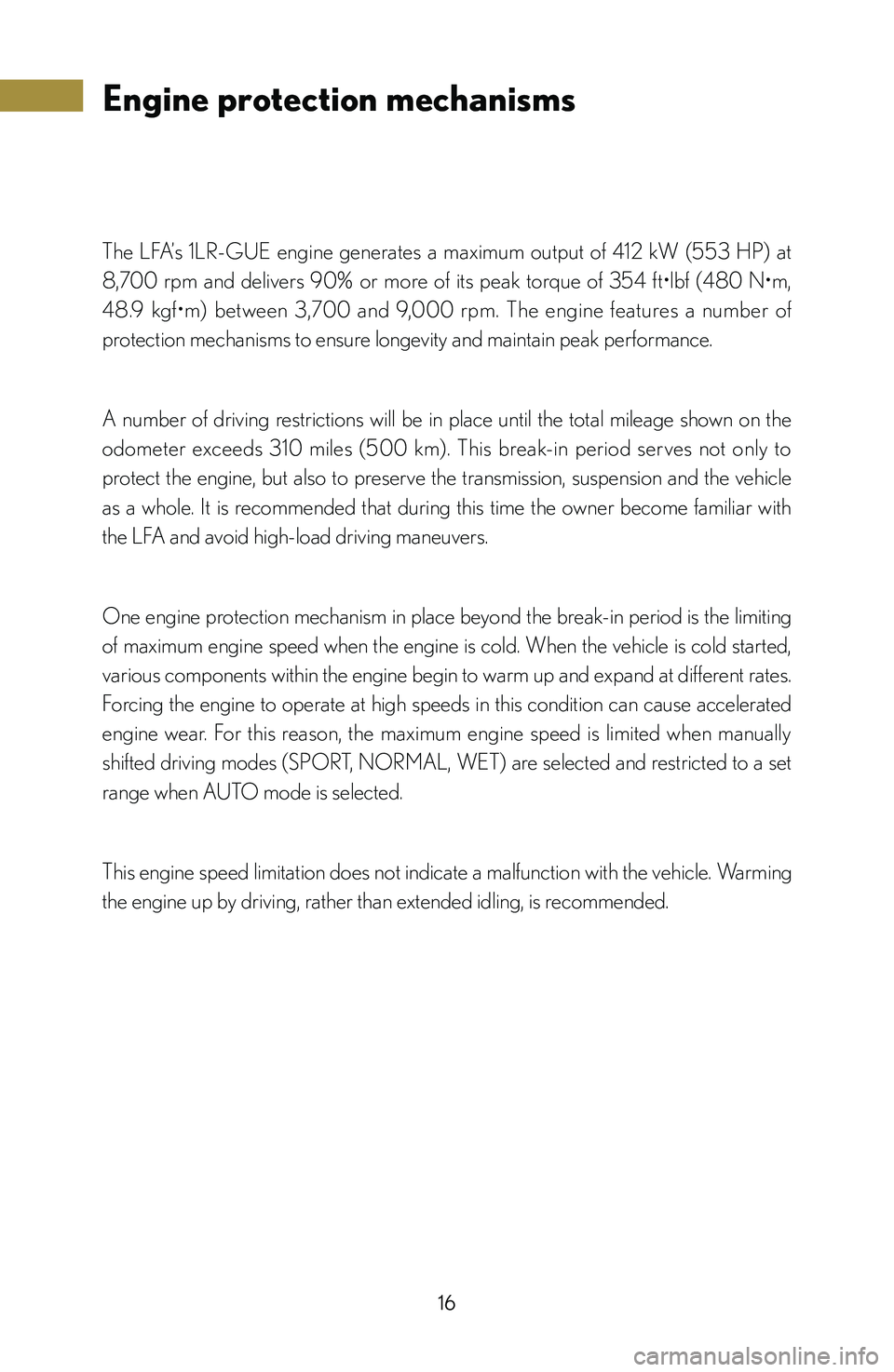
16
Engine protection mechanisms
The LFA’s 1LR-GUE engine generates a maximum output of 412 kW (553 HP) at
8,700 rpm and delivers 90% or more of its peak torque of 354 ft•lbf (480 N•m,
48.9 kgf•m) between 3,700 and 9,000 rpm. The engine features a number of
protection mechanisms to ensure longevity and maintain peak performance.
A number of driving restrictions will be in place until the total mileage shown on the
odometer exceeds 310 miles (500 km). This break-in period serves not only to
protect the engine, but also to preserve the transmission, suspension and the vehicle
as a whole. It is recommended that during this time the owner become familiar with
the LFA and avoid high-load driving maneuvers.
One engine protection mechanism in place beyond the break-in period is the limiting
of maximum engine speed when the engine is cold. When the vehicle is cold started,
various components within the engine begin to warm up and expand at different rates.
Forcing the engine to operate at high speeds in this condition can cause accelerated
engine wear. For this reason, the maximum engine speed is limited when manually
shifted driving modes (SPORT, NORMAL, WET) are selected and restricted to a set
range when AUTO mode is selected.
This engine speed limitation does not indicate a malfunction with the vehicle. Warming
the engine up by driving, rather than extended idling, is recommended.
Page 28 of 128
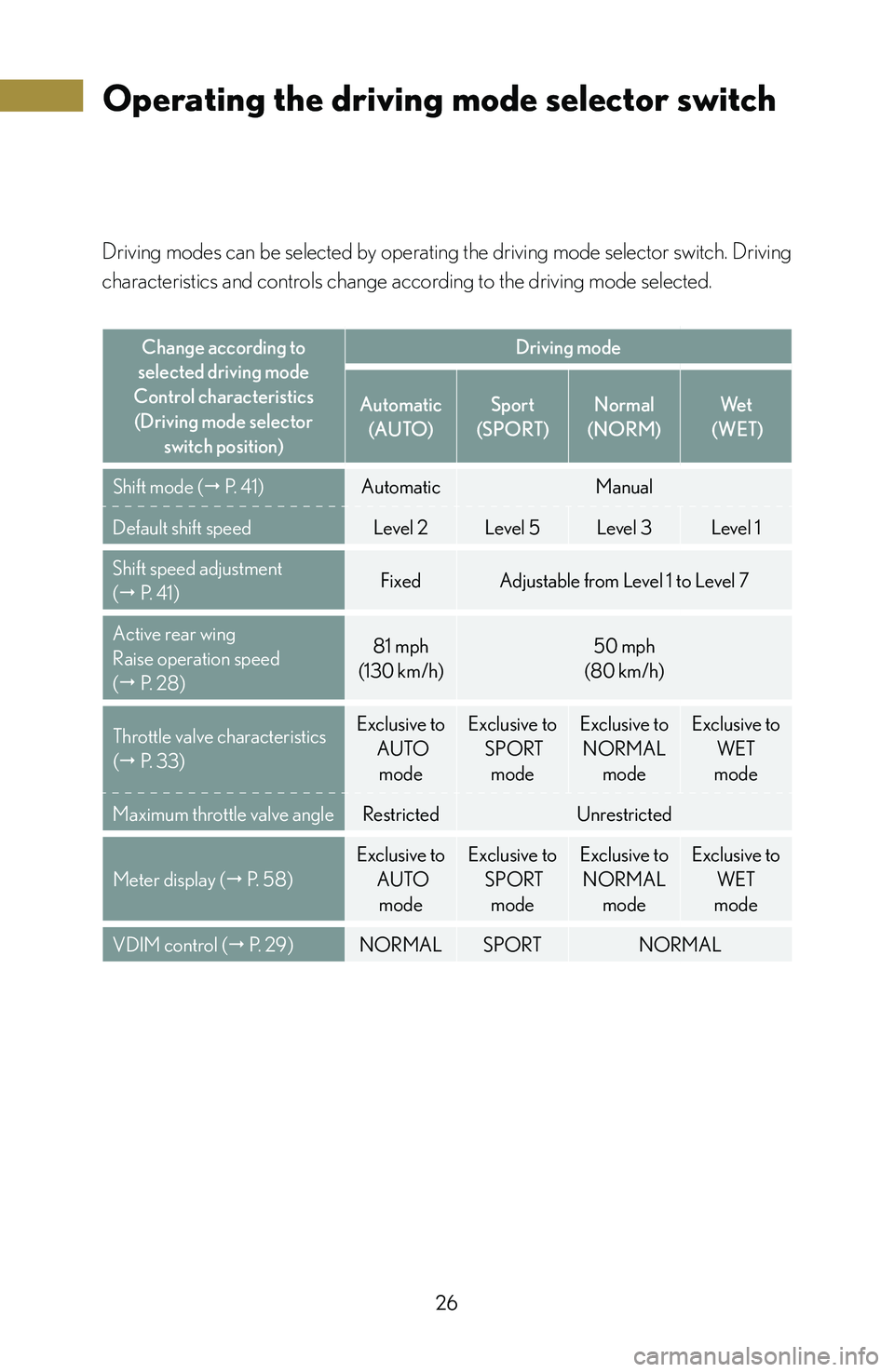
26
Operating the driving mode selector switch
Driving modes can be selected by operating the driving mode selector switch. Driving
characteristics and controls change according to the driving mode selected.
Change according to
selected driving mode
Control characteristics
(Driving mode selector
switch position)
Driving mode
Automatic
(AUTO)
Sport
(SPORT)
Normal
(NORM)Wet (WET)
Shift mode (" P. 41)
Automatic Manual
Default shift speed Level 2Level 5 Level 3 Level 1
Shift speed adjustment
(
" P. 41) Fixed
Adjustable from Level 1 to Level 7
Active rear wing
Raise operation speed
(
" P. 28) 81 mph
(130 km/h) 50 mph
(80 km/h)
Throttle valve characteristics
(
" P. 33) Exclusive to
AUTO mode Exclusive to
SPORT mode Exclusive to
NORMAL mode Exclusive to
WET
mode
Maximum throttle valve angle Restricted Unrestricted
Meter display (
" P. 58) Exclusive to
AUTO mode Exclusive to
SPORT mode Exclusive to
NORMAL mode Exclusive to
WET
mode
VDIM control (
" P. 29) NORMAL SPORT NORMAL
Page 29 of 128
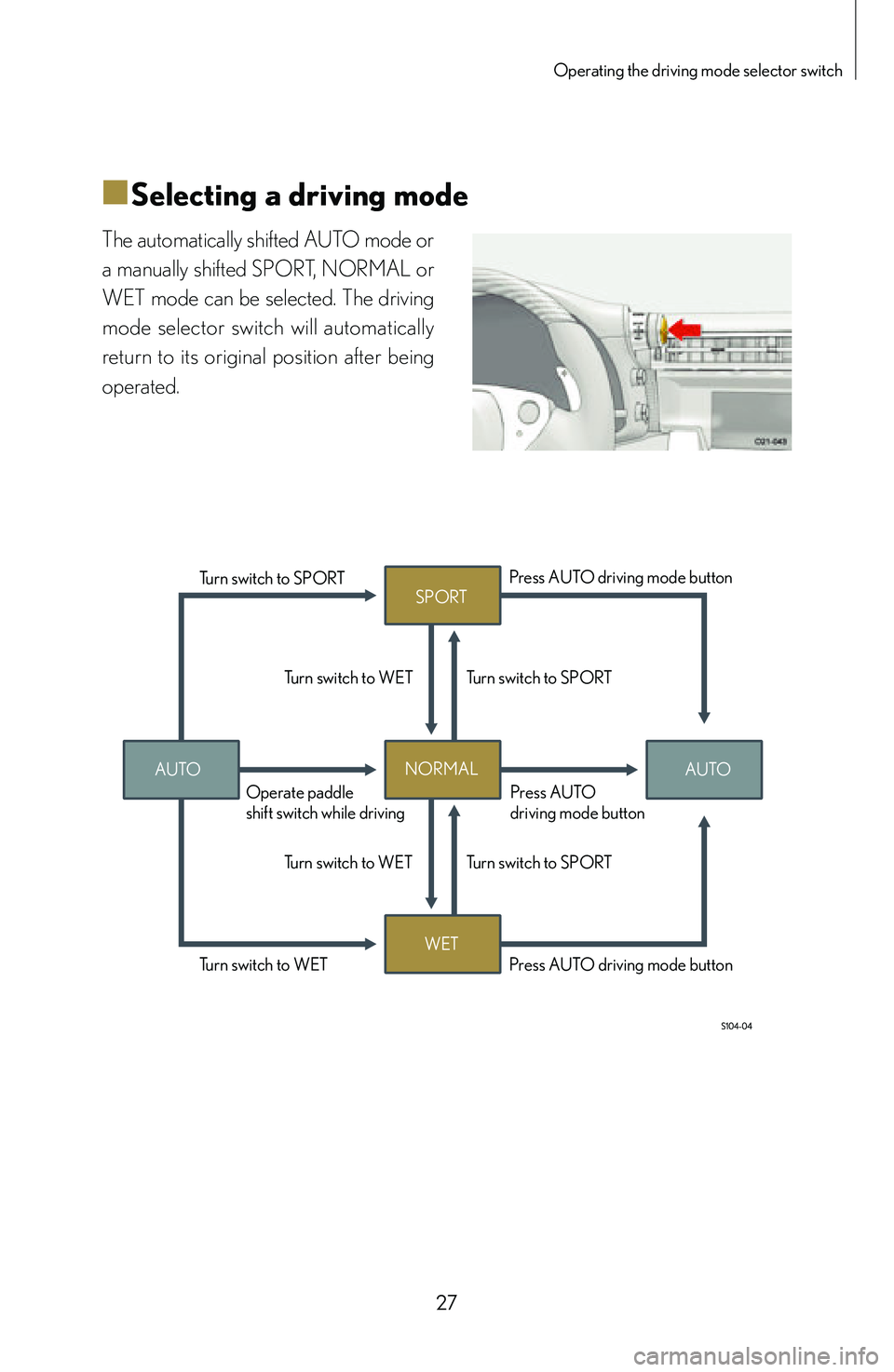
27
Operating the driving mode selector switch
■
■Selecting a driving mode
The automatically shifted AUTO mode or
a manually shifted SPORT, NORMAL or
WET mode can be selected. The driving
mode selector switch will automatically
return to its original position after being
operated.
AUTO NORMAL
AUTO
SPORT
WET
Turn switch to SPORT
Operate paddle
shift switch while driving
Turn switch to WET Press AUTO driving mode buttonPress AUTO
driving mode button
Turn switch to WET
Turn switch to WET Turn switch to SPORT
Turn switch to SPORTPress AUTO driving mode button
Page 30 of 128

28
■
■Active rear wing
The LFA’s active rear wing operates on a speed-linked schedule in accordance with
the selected driving mode. Control is performed by the ECU (Electronic Control
Unit).
Vehicle speed-linked active control allows for a reduced drag coefficient (Cd value)
when the wing is stowed. The wing is automatically raised to control airflow and
provide an appropriate level of downforce (-Cl value) at higher speeds, contributing
to handling stability.
Depending on the driving mode, the
active rear wing will rise in approximately
5 s e c o n d s w h e n t h e ve h i c l e s p e e d
exceeds 50 mph (80 km/h) or 81 mph
(130 km/h) respectively.
T h e w i n g w i l l a u t o m a t i c a l l y l owe r i n
a p p rox i m a t e l y 7 s e c o n d s w h e n t h e
vehicle slows to 25 mph (40 km/h) or
less.
The dif ference in rising and lowering
speeds is intended to minimize undesired aerodynamic changes due to frequent
operation.
Driving mode
SPORT/NORMAL/WET
Active rear wing operation speed
Raised
Speed [mph (km/h)] Lowered
25 (40) 50 (80)
Page 31 of 128

29
Operating the driving mode selector switch
■
■VDIM
The LFA employs VDIM (Vehicle Dynamics Integrated Management), a dynamic
control program that integrates braking and drive torque control to help ensure
overall vehicle stability and secure handling. VDIM also features vertical acceleration
and roll rate sensors, added exclusively for the LFA. The addition of these sensors
increases the precision and response of road camber estimation on banked roads,
such as “The Carousel” at the Nürburgring, to determine the vehicle’s performance
limits. This prevents excessive intervention on banked roads.
The LFA’s VDIM system allows for two individual control modes selected by the driver
using the driving mode selector switch.
When in SPORT mode, VDIM control is modified in order to enhance driving
pleasure and the driver’s confidence in the vehicle.
When not in SPORT mode, VDIM returns to NORMAL mode, designed to intervene
seamlessly as the vehicle reaches its performance limits, thereby realizing smoother
driving dynamics.
This helps ensure both overall vehicle stability and secure handling.
Page 35 of 128
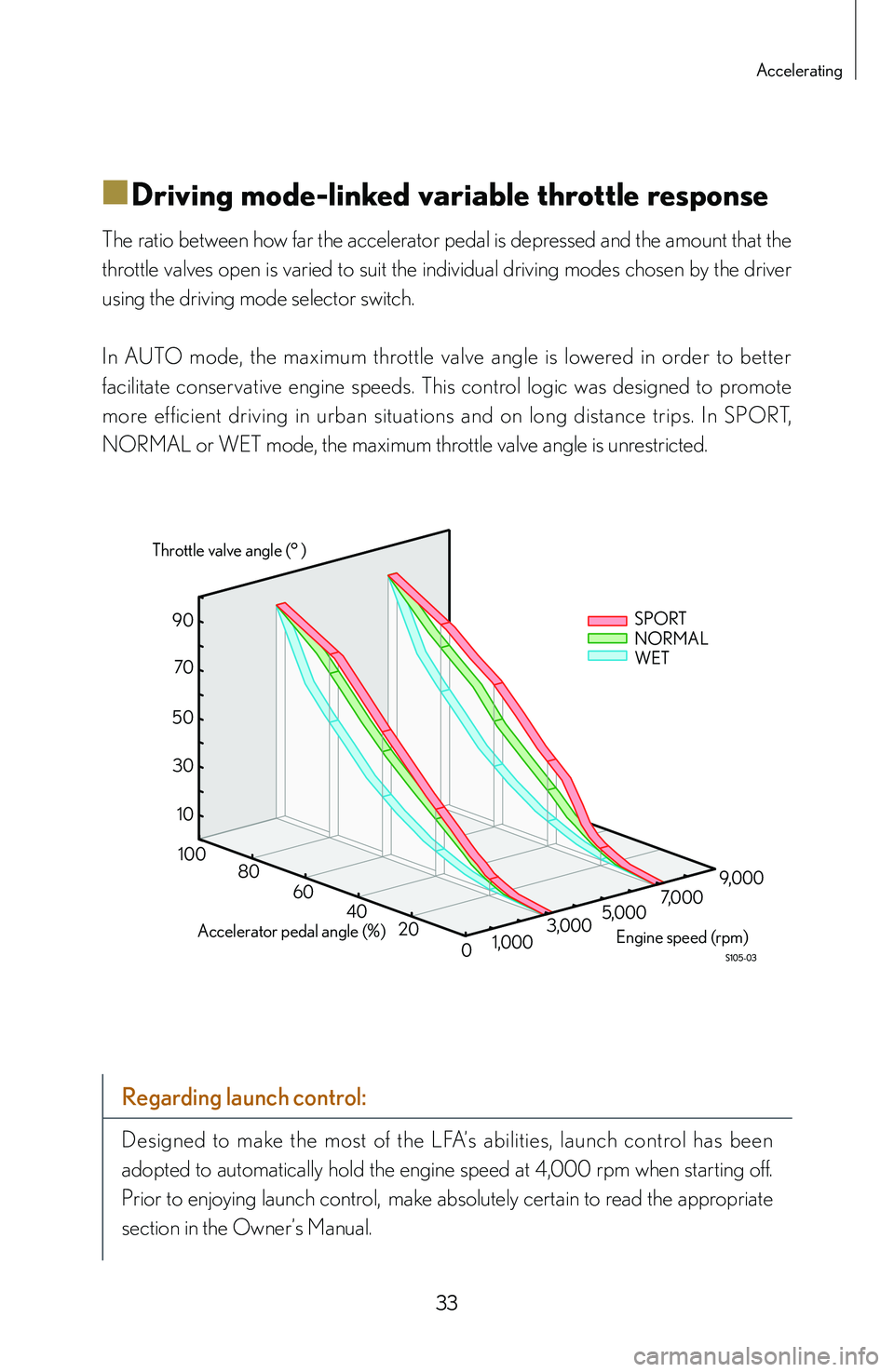
33
Accelerating
■
■Driving mode-linked variable throttle response
The ratio between how far the accelerator pedal is depressed and the amount that the
throttle valves open is varied to suit the individual driving modes chosen by the driver
using the driving mode selector switch.
In AUTO mode, the maximum throttle valve angle is lowered in order to better
facilitate conservative engine speeds. This control logic was designed to promote
more efficient driving in urban situations and on long distance trips. In SPORT,
NORMAL or WET mode, the maximum throttle valve angle is unrestricted.
SPORT
Engine speed (rpm)
Accelerator pedal angle (%)
Throttle valve angle (° )
WET NORMAL
90
70
50 30 10100 80
604020
01,000 3,000
5,000 7,0009,000
Regarding launch control:
Designed to make the most of the LFA’s abilities, launch control has been
adopted to automatically hold the engine speed at 4,000 rpm when starting off.
Prior to enjoying launch control,
make absolutely certain to read the appropriate
section in the Owner’s Manual.
Page 43 of 128
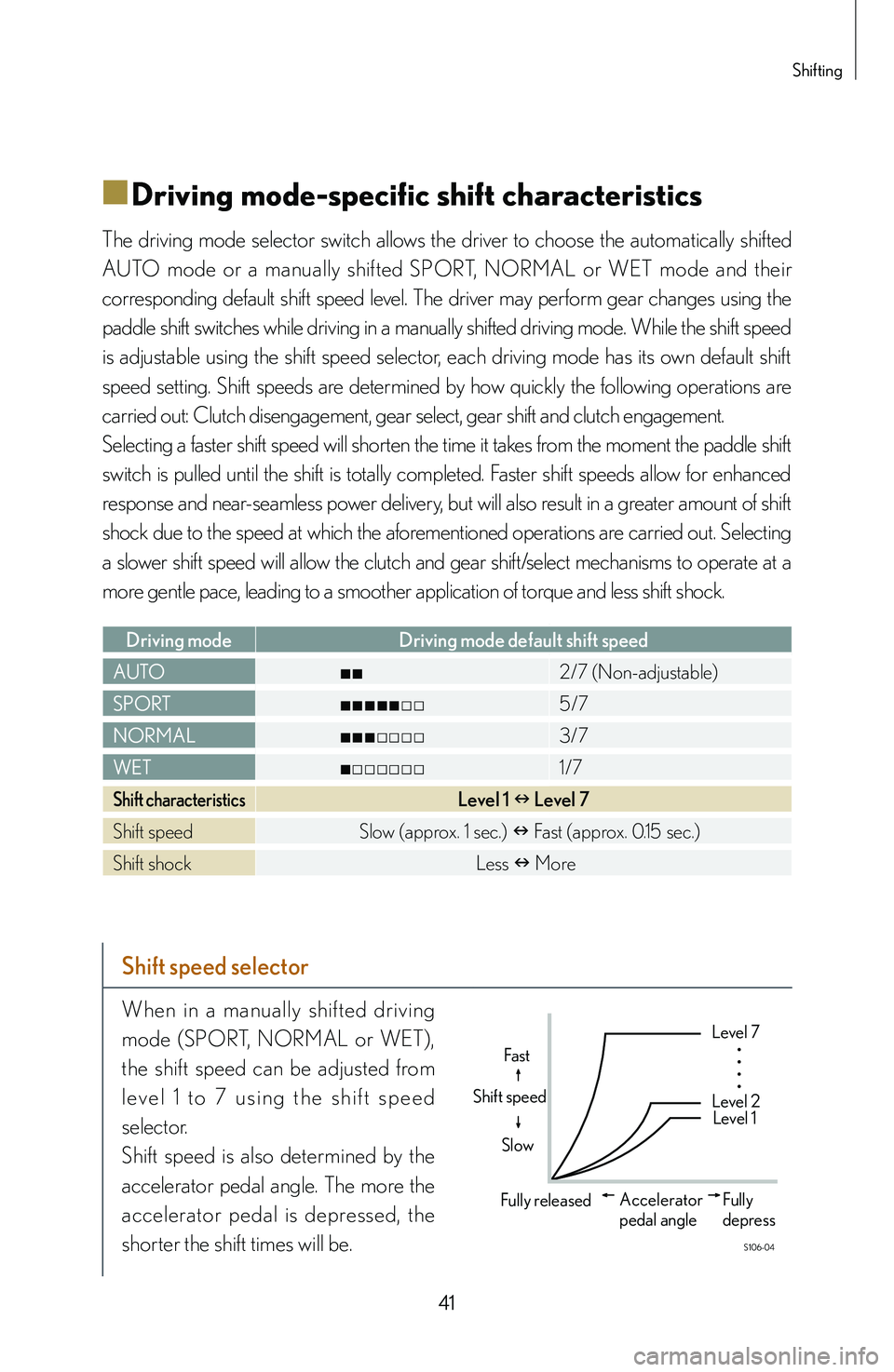
41
Shifting
■
■Driving mode-specific shift characteristics
The driving mode selector switch allows the driver to choose the automatically shifted
AUTO mode or a manually shifted SPORT, NORMAL or WET mode and their
corresponding default shift speed level. The driver may perform gear changes using the
paddle shift switches while driving in a manually shifted driving mode. While the shift speed
is adjustable using the shift speed selector, each driving mode has its own default shift
speed setting. Shift speeds are determined by how quickly the following operations are
carried out: Clutch disengagement, gear select, gear shift and clutch engagement.
Selecting a faster shift speed will shorten the time it takes from the moment the paddle shift
switch is pulled until the shift is totally completed. Faster shift speeds allow for enhanced
response and near-seamless power delivery, but will also result in a greater amount of shift
shock due to the speed at which the aforementioned operations are carried out. Selecting
a slower shift speed will allow the clutch and gear shift/select mechanisms to operate at a
more gentle pace, leading to a smoother application of torque and less shift shock.
Driving modeDriving mode default shift speed
AUTO ■■
2/7 (Non-adjustable)
SPORT ■■■■■□□
5/7
NORMAL ■■■□□□□
3/7
WET ■□□□□□□
1/7
Shift characteristicsLevel 1 n Level 7
Shift speed Slow (approx. 1 sec.) n
Fast (approx. 0.15 sec.)
Shift shock Less n
More
Shift speed selector
When in a manually shif ted driving
mode (SPORT, NORMAL or WET),
the shift speed can be adjusted from
l e v e l 1 t o 7 u s i n g t h e s h i f t s p e e d
selector.
Shift speed is also determined by the
accelerator pedal angle. The more the
accelerator pedal is depressed, the
shorter the shift times will be.
S106-04
Fast
Slow
Fully released Fully
depress
Level 1
Level 2 Level 7
Accelerator
pedal angle
Shift speed
Page 60 of 128
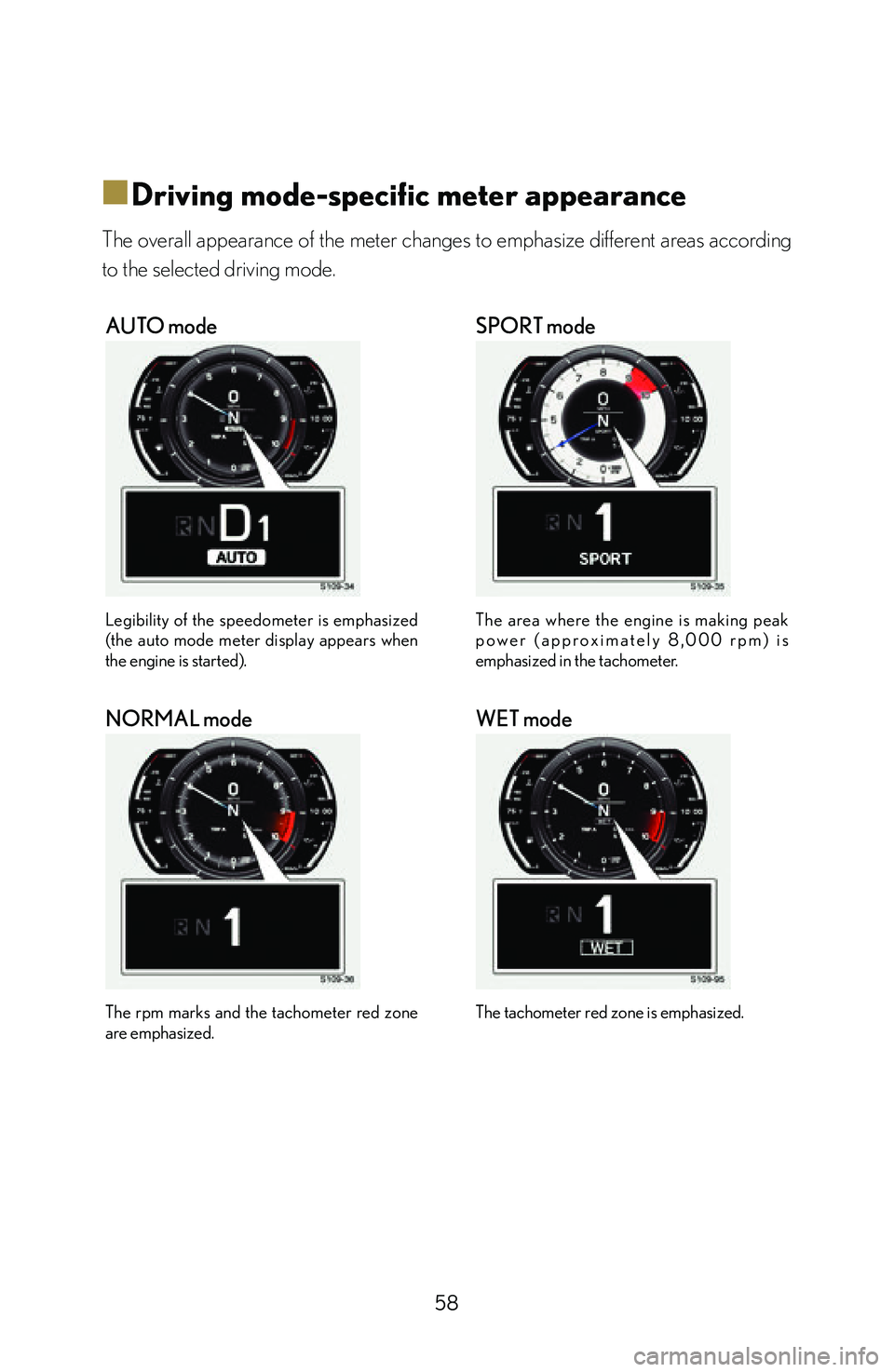
58
■
■Driving mode-specific meter appearance
The overall appearance of the meter changes to emphasize different areas according
to the selected driving mode.
AUTO mode
Legibility of the speedometer is emphasized
(the auto mode meter display appears when
the engine is started).
SPORT mode
The area where the engine is making peak
p o w e r ( a p p r o x i m a t e l y 8 , 0 0 0 r p m ) i s
emphasized in the tachometer.
NORMAL mode
The rpm marks and the tachometer red zone
are emphasized.
WET mode
The tachometer red zone is emphasized.
Page 122 of 128
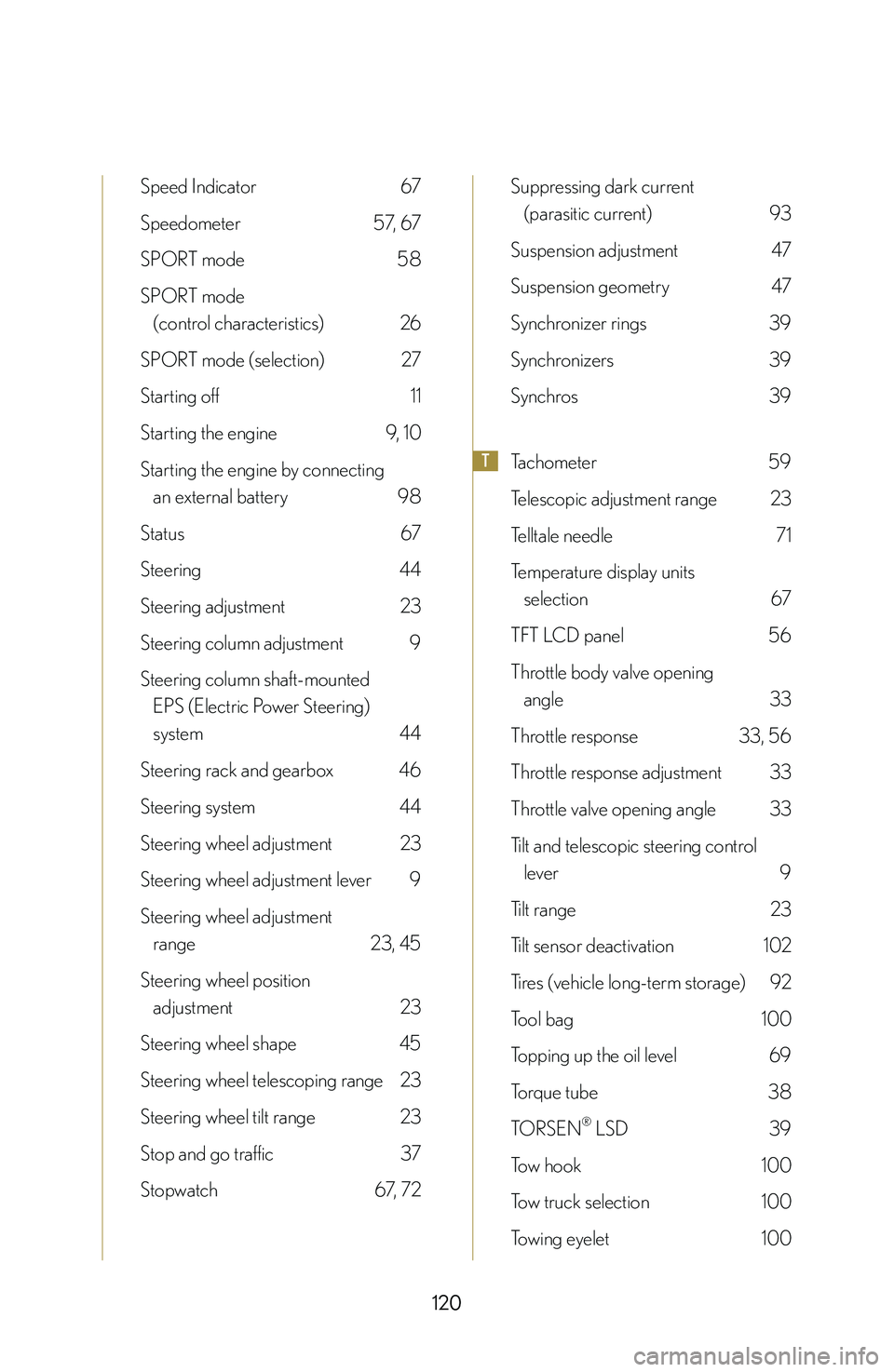
120
Speed Indicator 67
Speedometer 57, 67
SPORT mode 58
SPORT mode
(control characteristics) 26
SPORT mode (selection) 27
Starting off 11
Starting the engine 9, 1 0
Starting the engine by connecting
an external battery 98
Status 67
Steering 44
Steering adjustment 23
Steering column adjustment 9
Steering column shaft-mounted
EPS (Electric Power Steering)
system 44
Steering rack and gearbox 46
Steering system 44
Steering wheel adjustment 23
Steering wheel adjustment lever 9
Steering wheel adjustment
range 23, 45
Steering wheel position
adjustment 23
Steering wheel shape 45
Steering wheel telescoping range 23
Steering wheel tilt range 23
Stop and go traffic 37
Stopwatch 67 , 72
Suppressing dark current
(parasitic current) 93
Suspension adjustment 47
Suspension geometry 47
Synchronizer rings 39
Synchronizers 39
Synchros 39
TTachometer 59
Telescopic adjustment range 23
Telltale needle 71
Temperature display units
selection 67
TFT LCD panel 56
Throttle body valve opening
angle 33
Throttle response 33, 56
Throttle response adjustment 33
Throttle valve opening angle 33
Tilt and telescopic steering control
lever 9
Tilt range 23
Tilt sensor deactivation 102
Tires (vehicle long-term storage) 92
Tool bag 100
Topping up the oil level 69
Torque tube 38
TORSEN® LSD 39
Tow hook 100
Tow truck selection 100
Towing eyelet 100